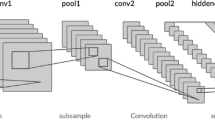Abstract
Catering to the widespread COVID-19 pandemic, the authors aim to develop a system based on machine learning combined with the knowledge of medical science. Considering the prevailing situation, it becomes necessary to diagnose the COVID-19 at initial stages. The idea behind the described designed model is to identify the spread of infection in patients as fast as possible. The paper sketches two different approaches: K-fold cross-validation and deep network designer which are based on deep learning technology for the prediction of COVID-19 in the initial stages by using the chest X-rays. The performance evaluation of the cross-fold validation process is compared with the designed application in the deep network designer to find an effective and efficient methodology for classification which attained better accuracy.
Access this chapter
Tax calculation will be finalised at checkout
Purchases are for personal use only
Similar content being viewed by others
References
Mishra M, Parashar V, Shimpi R (2020) Development and evaluation of an AI System for early detection of Covid-19 pneumonia using X-ray (Student Consortium). In: 2020 IEEE Sixth international conference on multimedia big data (BigMM). IEEE, pp 292–296. https://doi.org/10.1109/BigMM50055.2020.00051
Ismael AM, Şengür A (2021) Deep learning approaches for COVID-19 detection based on chest X-ray images. Expert Syst Appl 164
Chowdhury NK, Rahman MM, Kabir MA (2020) Pdcovidnet: a parallel-dilated convolutional neural network architecture for detecting COVID-19 from chest x-ray images. Health Inf Sci Syst 8(1):1–14
Hussain E, Hasan M, Rahman MA, Lee I, Tamanna T, Parvez MZ (2021) CoroDet: a deep learning based classification for COVID-19 detection using chest X-ray images. Chaos, Solitons Fractals 142:110495. ISSN: 0960-0779
Jain G, Mittal D, Thakur D, Mittal MK (2020) A deep learning approach to detect Covid-19 coronavirus with X-ray images. Biocybernetics Biomed Eng 40(4):1391–1405. ISSN: 0208-5216
Attia SJ (2016) Enhancement of chest X-ray images for diagnosis purposes. J Nat Sci Res 6(2). ISSN: 2224-3186
Albawi S, Mohammed TA, Al-Zawi S (2017) Understanding of a convolutional neural network. In: 2017 International conference on engineering and technology (ICET). IEEE, pp 1–6. https://doi.org/10.1109/ICEngTechnol.2017.8308186
He K, Zhang X, Ren S, Sun J (2016) Deep residual learning for image recognition. In: 2016 IEEE conference on computer vision and pattern recognition (CVPR). IEEE, pp 770–778. https://doi.org/10.1109/CVPR.2016.90
Kumar R, Arora R, Bansal V, Sahayasheela VJ, Buckchash H, Imran J et al (2020) Accurate prediction of COVID-19 using chest X-ray images through deep feature learning model with SMOTE and machine learning classifiers. medRxiv
Narayanan BN, Davuluru VSP, Hardie RC (2020) Two-stage deep learning architecture for pneumonia detection and its diagnosis in chest radiographs. In: Medical imaging 2020: imaging informatics for healthcare, research, and applications. Int Soc Opt Photonics 11318:130–139
Ikhsan IAM, Hussain A, Zulkifley MA, Tahir NM, Mustapha A (2014) An analysis of x-ray image enhancement methods for vertebral bone segmentation. In: 2014 IEEE 10th International colloquium on signal processing and its applications. IEEE, pp 208–211. https://doi.org/10.1109/CSPA.2014.6805749
Fushiki T (2011) Estimation of prediction error by using K-fold cross-validation. Stat Comput 21(2):137–146
Author information
Authors and Affiliations
Corresponding author
Editor information
Editors and Affiliations
Rights and permissions
Copyright information
© 2023 The Author(s), under exclusive license to Springer Nature Singapore Pte Ltd.
About this paper
Cite this paper
Patel, M., Padiya, J., Patel, M.I. (2023). Deep Learning-Based COVID-19 Detection Using Transfer Learning Through ResNet-50. In: Dhavse, R., Kumar, V., Monteleone, S. (eds) Emerging Technology Trends in Electronics, Communication and Networking. Lecture Notes in Electrical Engineering, vol 952. Springer, Singapore. https://doi.org/10.1007/978-981-19-6737-5_21
Download citation
DOI: https://doi.org/10.1007/978-981-19-6737-5_21
Published:
Publisher Name: Springer, Singapore
Print ISBN: 978-981-19-6736-8
Online ISBN: 978-981-19-6737-5
eBook Packages: Computer ScienceComputer Science (R0)




